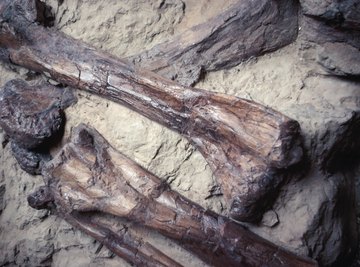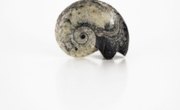
Field geologists study rocks in their natural locations within the environment, or in situ. They have limited testing methods at their disposal and must rely primarily on sight, touch, a few simple tools and extensive knowledge of rocks, minerals and rock formation to identify different rock layers. Rocks are classified into three main types, sedimentary, igneous and metamorphic, based on origin and density. Rock layers are classified into three main groups, Paleozoic, Mesozoic and Cenozoic, based on geological era of deposition.
Crusty Surface
Rock is the hard, abiotic material, composed of minerals, that forms the Earth's outer layers. Rock layers are governed by the law of superposition, which states that older layers are at deeper levels and newer layers are closer to the surface. However, the reality in the field is not so simple. While some areas have undisturbed layers in orderly succession, geological events have left other areas in a confusing jumble. Igneous intrusions and extrusions are formed when magma flows through the rock layers from below and lava melts into them from above. Earth- and seaquakes and tectonic movement can fold rock layers or completely break and lift them in faults. Severe upheaval can cause erosion unconformity, where an uplifted area erodes, then subsides back down, only to be covered by new deposition. All of these can make sorting through the layers very confusing.
Laid Down and Tossed Around
Most rock is sedimentary. It's deposited in layers by water. Sedimentary rock is usually found directly underneath soil or silt. Igneous rock hardens directly from magma or lava. It can be found on the surface or deposited in columns or pools throughout other rock layers. Metamorphic means "transforming," and metamorphic rock includes the bedrock of Earth and very deep crust rock that's been compressed by the enormous pressure of the rock, water, soil and biomass above it.
Touch and Site
Field geologists observe texture, hardness and composition of rocks to identify the layers they came from. Typically the harder and more densely packed the particles are, the older the rock and the deeper the layer it came from. Hardness can be tested with a simple fingernail or pocket tool. They also look at crystallization by observing a rock's cleavage pattern and luster because igneous and sedimentary rocks reflect light differently. Color and shape also give clues to a rock's parent layer.
Ancient Inhabitants
Fossils help field geologists identify the three major groups of rock layers, classified according to geologic era. The Paleozoic layer (542 to 251 million years ago) is a record of the earliest life on Earth. Its fossils range from invertebrates through the first jawless fish, up to early jawed fish, amphibians and reptiles, but stop before dinosaurs and mammals. The Mesozoic layer (251 to 65.5 million years ago) contains the remains of dinosaurs and the first mammals and flowering plants. The Cenozoic layer (65.5 million years ago to the present) begins around the first archaic birds, contains fossils of the first modern mammals and continues up to the present day.
References
About the Author
Angela Libal began writing professionally in 2005. She has published several books, specializing in zoology and animal husbandry. Libal holds a degree in behavioral science: animal science from Moorpark College, a Bachelor of Arts from Sarah Lawrence College and is a graduate student in cryptozoology.
Photo Credits
Hemera Technologies/AbleStock.com/Getty Images
